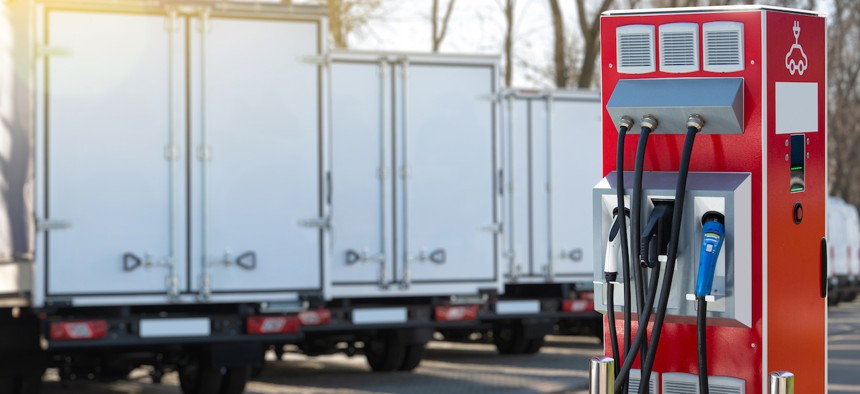
The federal fleet consists of more than 650,000 vehicles and less than 1% of that total are currently electric. Scharfsinn86/Getty Images
Federal Agencies Could Save $6B by Electrifying Their Fleets, Report Finds
President Biden has ordered agencies to take swift action to stop buying polluting vehicles.
The federal government could save $6 billion over the next 15 years by converting its fleet to electric vehicles, according to a new report, which found the long-term savings far outweigh the upfront costs.
The government will have to put up $4.6 billion in added costs to buy the new vehicles over the more standard variety, the ICF Climate Center found, but would break even by 2028 and realize billions of dollars in savings thereafter. The researchers launched their review after President Biden ordered federal agencies to stop purchasing emission cars, trucks and vans by 2027 and to cease buying any internal combustion engine non-tactical vehicles at all by 2035.
The federal fleet consists of more than 650,000 vehicles and less than 1% of that total are currently electric. Federal agencies are well-suited for electrification, according to the report’s authors, Scott Walsh, ICF’s director for climate and transportation, and Ambika Coletti, a senior manager for beneficial electrification, as the average federal vehicle is driven just 25 miles per day. They added that so long as federal fleet managers plan appropriately and phase in their approach, Biden’s order—and, eventually, full electrification—is within reach.
“Our analysis tells us that what the executive order is asking for is something that the market can deliver, and can deliver in a way that's actually going to save taxpayer dollars,” Walsh said.
A phased approach offers several benefits, the authors said, including allowing the private sector to ramp up production to meet the new demand. It would also allow fleet managers to learn how to best take advantage of technological developments and provide more time for EV efficiency and price points to improve.
Coletti cautioned that agencies should also start early to plan with utilities to ensure local grids can handle the increased power load. They would also have to assess each location or facility and adjust their internal power management appropriately. ICF looked at the broad picture of the federal fleet, but Coletti said individual agencies would have to use more granular data not available to the public to determine more specific needs.
Walsh called the $6 billion in net savings estimate “conservative,” noting, for example, the General Services Administration negotiates better prices for agencies than the commercial, off-the-shelf rates used in the report. The report also assumes the government will convert its entire fleet in 2024 and since the government will inevitably take a slower approach, it will be able to realize more gains in the industry.
GSA, which owns most of the federal fleet, does not issue mandates on which or how many vehicles agencies must lease or purchase, leaving that up to each individual federal office to determine. It now has 74 EV models available, up from just 10 in 2021. Last month, GSA launched a new "electric vehicle suitability assessment tool," allowing federal agencies to identify which parts of its fleet can be replaced with EVs based on function and range requirements.
The reduction in greenhouse gas emissions would result in added social benefits valued at an additional $1.2 billion, Coletti and Walsh found, and would push consumers writ large to pursue more EVs.
“I think it would act as a catalyst to even further accelerate the growth of the EV market,” Walsh said, “and as a result, drive unit costs down because of economies of scale.”
He added as he and Coletti began their research, they expected to identify a net cost that would be offset by environmental benefits.
“That $6 billion savings number really was a surprise to us,” Walsh said.
The U.S. Postal Service, which maintains its own fleet separate from GSA of more than 200,000 vehicles, is currently in the process of replacing most of its vans and trucks. After a drawn out fight between postal management, the Biden administration, lawmakers and environmental groups over how many of those vehicles should be electric, Congress intervened and provided $3 billion for USPS to purchase a higher rate of EVs and charging stations. After negotiations with the White House, Postmaster General Louis DeJoy announced 75% of the vehicles USPS will purchase will be electric. USPS will begin installing charging stations this year and will initially purchase 66,000, one for each of the EVs it plans to buy over the next several years.
For its analysis, ICF assumed agencies would purchase just one charger for every two EVs. Coletti said some agencies will require a one-to-one ratio and others may need just one for every three vehicles, leading to the two-to-one estimate.







